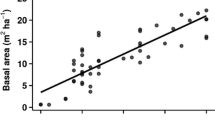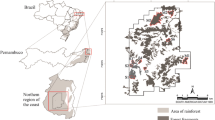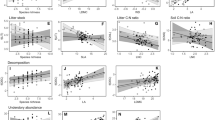Abstract
Traits and functional strategies when related to demographic rates provide important information about the distribution of species and their performance in different environments. Therefore, predictions were made that: (1) plant communities in tropical forests, distributed over a chronosequence, have different trade-offs between demographic rates and functional traits due to variations in light availability and (2) acquisitive, intermediate and conservative species have different demographic rates throughout the chronosequence. To test these predictions, data from eight functional traits (maximum plant height; specific leaf area; leaf dry matter content; leaf nitrogen, phosphorus and chlorophyll concentrations; wood density; and seed shape) were collected from 64 tree species, distributed in six secondary (three 17 and three 25 years old) and three mature (>40 years old) Ombrophilous Dense Forest fragments. Demographic rates (mortality, recruitment and growth) of the species were determined for periods of three and five years, in each forest. Mortality was higher and growth rate was lower in the 17-year-old than in the mature forest, and the acquisitive group had the highest recruiting rate, but interactions were not significant. Thus, the majority of relationships between demographic rates and functional traits did not correspond to the predictions, as some traits were not better predictors of the demography of species in a determined forest than others and that these relationships did not vary across the chronosequence. Therefore, the trade-offs between functional and demographic characteristics are related to the species and not to environmental differences across the age gradient, and when the species are separated into groups, the predicted changes in demography are valid across the gradient.
Similar content being viewed by others
References
Bremner JM (1996) Nitrogen total. In: Sparks, DL (ed) Methods of soil analysis. Part 3. American Society of Agronomy, pp 1085–1121 (SSSA Book Series, 5)
Chase JM, Myers JA (2011) Disentangling the importance of ecological niches from stochastic processes across scales. Philos Trans R Soc B 366:2351–2363
Chave J (2005) Measuring wood density for tropical forest trees. A field manual for the CTFS sites. Universite Paul Sabatier, Toulouse
Chave J, Coomes D, Jansen S, Lewis SL, Swenson NG, Zanne AE (2009) Towards a worldwide wood economics spectrum. Ecol Lett 12:351–366
Chazdon RL, Finegan B, Capers RS, Salgado-Negret B, Casanoves F, Boukili V, Norden N (2010) Composition and dynamics of functional groups of trees during tropical forest succession. Biotropica 42:31–40
Cornelissen JHC, Lavorel S, Garnier E, Díaz S, Buchmann N, Gurevich DE, Reich PB, Ter Steege H, Morgan HD, Van der Heijden MGA, Pausas JG, Pooter H (2003) A handbook of protocols for standardized and easy measurement of plant functional traits worldwide. Aust J Bot 51:335–380
Cornwell WK, Ackerly DD (2009) Community assembly and shifts in plant trait distributions across an environmental gradient in Coastal California. Ecol Monogr 79:109–126
Coste S, Baraloto C, Leroy C, Marcon E, Renaud A, Richardson AD, Roggy JC, Schimann H, Uddling J, Herault B (2010) Assessing foliar chlorophyll contents with the SPAD-502 chlorophyll meter: a calibration test with thirteen tree species of tropical rainforest in French Guiana. Ann For Sci 67:607
CPRH - Companhia Pernambucana do Meio Ambiente (2003) Diagnóstico socioambiental do litoral norte de Pernambuco. CPRH, Recife
Cramer JM, Mesquita RCG, Williamson GB (2007) Forest fragmentation differentially affects seed dispersal of large and small-seeded tropical trees. Biol Cons 137:415–423
Davies TJ, Barraclough TG, Chase MW, Soltis PS, Soltis DE, Savolainen V (2004) Darwin’s abominable mystery: insights from a supertree of the angiosperms. Proc Natl Acad Sci USA 101:1904–1909
Douma JC, Shipley B, Witte JPM, Aerts R, Van Bodegom PM (2012) Disturbance and resource availability act differently on the same suite of plant traits: revisiting assembly hypotheses. Ecology 93:825–835
Freschet GT, Cornelissen JHC, Van Logtestijn RSP, Aerts R (2010) Evidence of the ‘plant economics spectrum’ in a subarctic flora. J Ecol 98:362–373
Gonzalez A, Loreau M (2009) The causes and consequences of compensatory dynamics in ecological communities. Annu Rev Ecol Evol Syst 40:393–414
Gotelli NJ, Ellison AM (2004) A primer of ecological statistics. Sinauer Associates Inc., Sunderland
Kooyman RM, Westoby M (2009) Costs of height gain in rainforest saplings: main stem scaling, functional traits and strategy variation across 75 species. Ann Bot 104:987–993
Kraft NJB, Metz MR, Condit RS, Chave J (2010) The relationship between wood density and mortality in a global tropical forest data set. New Phytol 188:1124–1136
Lasky JR, Sun I, Su S, Chen Z, Keitt TH (2013) Trait-mediated effects of environmental filtering on tree community dynamics. J Ecol 101:722–733
Letcher SG, Chazdon RL (2009) Rapid recovery of biomass, species richness, and species composition in a forest chronosequence in Northeastern Costa Rica. Biotropica 41:608–617
Lins-e-Silva ACB (2010) Influência da área e da heterogeneidade de habitats na diversidade vegetal em fragmentos de Floresta Atlântica. Tese (Doutorado em Ecologia) - Centro de Ciências, Universidade Federal do Rio de Janeiro, Rio de Janeiro, 2010
Lohbeck M, Poorter L, Lebrija-Trejos E, Martı´nez-Ramos M, Meave JA, Paz H, Pe´rez-Garcı´a EA, Romero-Pe´rez E, Tauro A, Bongers F (2013) Successional changes in functional composition contrast for dry and wet tropical Forest. Ecology 94:1211–1216
Martinez-Vilalta J, Mencuccini M, Vayreda J, Retana J (2010) Interspecific variation in functional traits, not climatic differences among species ranges, determines demographic rates across 44 temperate and Mediterranean tree species. J Ecol 98:1462–1475
Mason NWH, Richardson SJ, Peltzer DA, Bello F, Wardle DA, Allen RB (2012) Changes in coexistence mechanisms along a long-term soil chronosequence revealed by functional trait diversity. J Ecol 100:678–689
Mccune B, Grace JB (2002) Analysis of ecological communities. MjM Software, Gleneden Beach, Oregon, USA (www.pcord.com)
Mccune B, Mefford MJ (2011) PC-ORD: Multivariate analysis of ecological data. version 6. MjM Software, Gleneden Beach, Oregon
Mouchet MA, Villeger S, Mason NWH, Mouillot D (2010) Functional diversity measures: an overview of their redundancy and their ability to discriminate community assembly rules. Funct Ecol 24:867–876
Nascimento LM, Sampaio EVSB, Rodal MJN, Lins-E-Silva ACB (2014) Secondary succession in a fragmented Atlantic Forest landscape: evidence of structural and diversity convergence along a chronosequence. J For Res 19:501–513
O’Neal ME, Landis DA, Isaacs R (2002) An inexpensive, accurate method for measuring leaf area and defoliation through digital image analysis. J Econ Entomol 95:1190–1194
Pagel MD (1992) Method for the analysis of comparative data. J Theor Biol 156:431–442
Pérez-Ramos IM, Roumet C, Cruz P, Blanchard A, Autran P, Garnier E (2012) Evidence for a ‘plant community economics spectrum’ driven by nutrient and water limitations in a Mediterranean rangeland of southern France. J Ecol 100:1315–1327
Poorter L (2008) The relationships of wood, gas and water fractions of tree stems to performance and life history variation in tropical trees. Ann Bot 102:367–375
Poorter H, Niinemets U, Poorter L, Wright IJ, Villar R (2009) Causes and consequences of variation in leaf mass per area (LMA): a meta-analysis. New Phytol 182:565–588
Poorter L, Mcdonald I, Alarco A, Fichtler E, Licona JC, Pena-Claros M, Sterck F, Villegas Z, Sass-Klaassen U (2010) The importance of wood traits and hydraulic conductance for the performance and life history strategies of 42 rainforest tree species. New Phytol 185:481–492
Rabelo FRC, Lins-e-Silva ACB, Rodal MJN (2015) Dinâmica da vegetação em um fragmento de Mata Atlântica no nordeste do Brasil. Ci Fl 25:23–36
Rocha MR, Gaedke U, Vasseur DA (2011) Functionally similar species have similar dynamic. J Ecol 99:1453–1459
Rozendaal DMA, Hurtado VH, Poorter L (2006) Plasticity in leaf traits of 38 tropical tree species in response to light; relationships with light demand and adult stature. Funct Ecol 20:207–216
Ruger N, Wirth C, Wright SJ, Condit R (2012) Functional traits explain light and size response of growth rates in tropical tree species. Ecology 93:2626–2636
Russo SE, Brown P, Tan S, Davies SJ (2008) Interspecific demographic trade-offs and soil-related habitat associations of tree species along resource gradients. J Ecol 96:192–203
Schessl M, Silva WL, Gottsberger G (2008) Effects of fragmentation on forest structure and litter dynamics in Atlantic rainforest in Pernambuco, Brazil. Flora 203:215–228
Schleicher A, Peppler-Lisbach C, Kleyer M (2011) Functional traits during succession: is plant community assembly trait-driven? Preslia 83:347–370
Sheil D, Burslem DFRP, Alder D (1995) The interpretation and misinterpretation of mortality rate measures. J Ecol 83:331–333
Thomas RQ, Kellner JR, Clark DB, Peart DR (2013) Low mortality in tall tropical trees. Ecology 94:920–929
Thompson K, Band SR, Hodgson JG (1993) Seed size and shape predict persistence in soil. Funct Ecol 7:236–241
Trindade MB, Lins-E-Silva ACB, Silva HP, Filgueira SB, Schessl M (2008) Fragmentation of the Atlantic rainforest in the Northern coastal region of Pernambuco, Brazil: recent changes and implications for conservation. Biorem Biodiv Bioavail 2:5–13
Trugilho PF, Silva DA, Frazão FJL, Matos JLM (1990) Comparação de métodos de determinação da densidade básica em madeira. Acta Amaz 20:307–319
Uriarte M, Clark JS, Zimmerman JK, Comita LS, Forero MJ, Thompson J (2012) Multidimensional trade-offs in species responses to disturbance: implications for diversity in a subtropical forest. Ecology 93:191–205
Veloso HP, Rangel Filho ALR, Lima JCA (1991) Classificação da vegetação brasileira, adaptada a um sistema universal. IBGE, Rio de Janeiro
Violle C, Navas M, Vile D, Kazakou E, Fortunel C, Hummel I, Garnier E (2007) Let the concept of trait be functional! Oikos 116:882–892
Webb CO, Donoghue MJ (2005) Phylomatic: tree assembly for applied phylogenetics. Mol Ecol Notes 5:181–183
Webb CT, Hoeting JA, Ames GM, Pyne MI, Poff NL (2010) A structured and dynamic framework to advance traits-based theory and prediction in ecology. Ecol Lett 13:267–283
Weiher E, Van Der Werf A, Thompson K, Roderick M, Garnier E, Eriksson O (1999) Challenging Theophrastus: a common core list of plant traits for functional ecology. J Veg Sci 10:609–620
Welden CW, Hewett SW, Hubbell SP, Foster RB (1991) Sapling survival, growth, and recruitment: relationship to canopy height in a neotropical forest. Ecology 72:35–50
Westoby M, Wright IJ (2006) Land-plant ecology on the basis of functional traits. Trends Ecol Evol 21:261–268
Westoby M, Falster DS, Moles AT, Vesk PA, Wright IJ (2002) Plant ecological strategies: some leading dimensions of variation between species. Annu Rev Ecol Syst 33:125–159
Wright IJ, Reich PB, Westoby M, Ackerly DD, Baruch Z, Bongers F, Cavender-Bares J, Chapin T, Cornelissen JH, Diemer M, Flexas J, Garnier E, Groom PK, Gulias J, Hikosaka K, Lamont BB, Lee T, Lee W, Lusk C, Midgley JJ, Navas ML, Niinemets U, Oleksyn J, Osada N, Poorter H, Poot P, Prior L, Pyankov VI, Roumet C, Thomas SC, Tjoelker MG, Veneklaas EJ, Villar R (2004) The worldwide leaf economics spectrum. Nature 428:821–827
Wright SJ, Kitajima K, Kraft NJ, Reich PB, Wright IJ, Bunker DE, Condit R, Dalling JW, Davies SJ, Díaz S, Engelbrecht BM, Harms KE, Hubbell SP, Marks CO, Ruiz-Jaen MC, Salvador CM, Zanne AE (2010) Functional traits and the growth-mortality trade-off in tropical trees. Ecology 91:3664–3674
Author information
Authors and Affiliations
Corresponding author
Appendix
Appendix
Principal component analysis of the eight functional characteristics measured for 64 species of trees. Values in parentheses on the axes are percentages of the calculated variance. Abbreviations for functional characteristics are defined in Table 3
Rights and permissions
About this article
Cite this article
Silva, M.A.M., Pinto, A.V.F., do Nascimento, L.M. et al. Traits and functional strategies as predictors of demographic variations over a chronosequence. Braz. J. Bot 40, 761–770 (2017). https://doi.org/10.1007/s40415-017-0389-9
Received:
Accepted:
Published:
Issue Date:
DOI: https://doi.org/10.1007/s40415-017-0389-9





